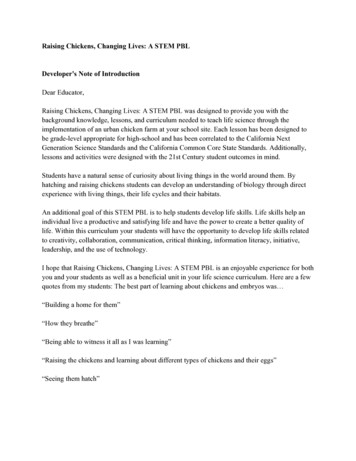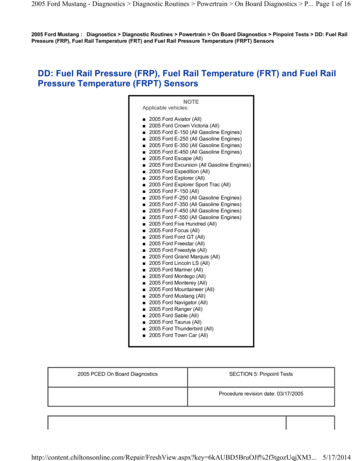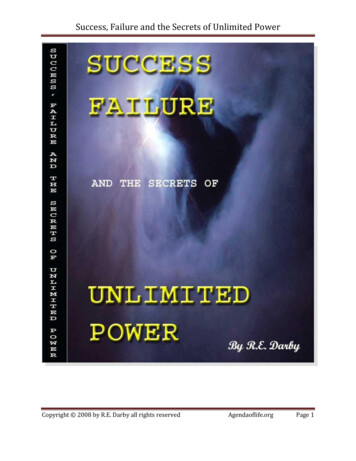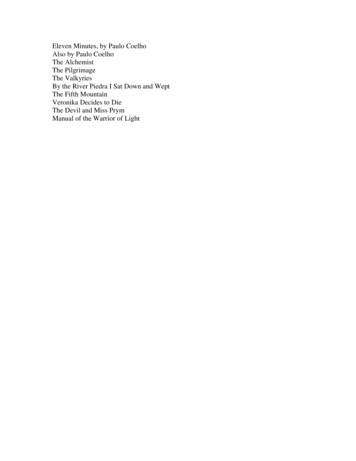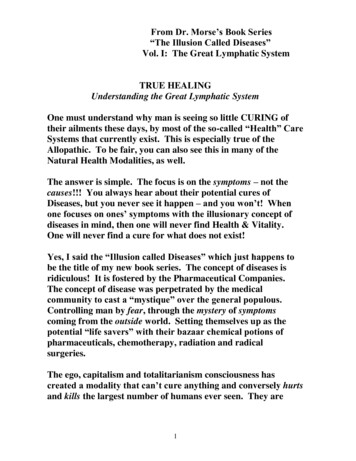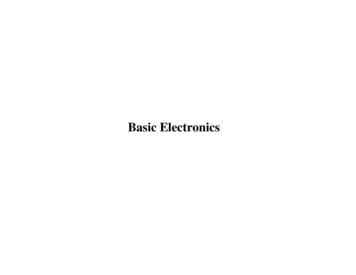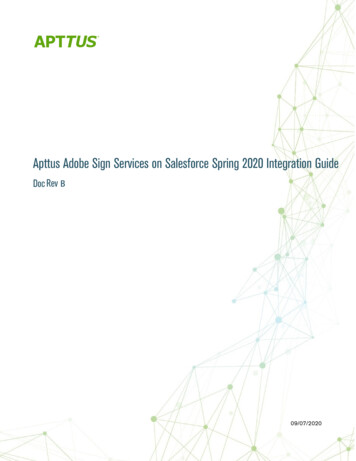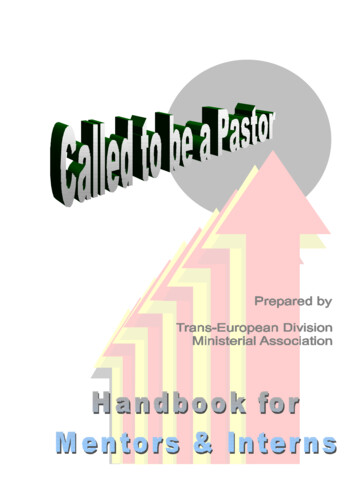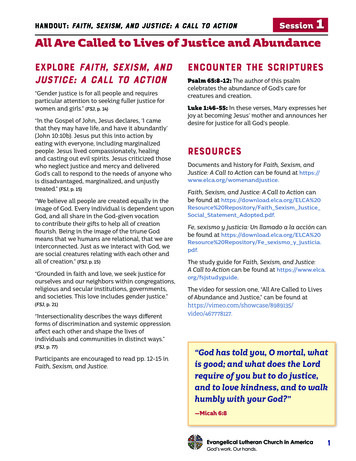
Transcription
Handout: Faith, Sexism, and Justice: A Call to ActionSession1All Are Called to Lives of Justice and AbundanceExplore Faith, Sexism, andJustice: A Call to Action“Gender justice is for all people and requiresparticular attention to seeking fuller justice forwomen and girls.” (FSJ, p. 14)“In the Gospel of John, Jesus declares, ‘I camethat they may have life, and have it abundantly’(John 10:10b). Jesus put this into action byeating with everyone, including marginalizedpeople. Jesus lived compassionately, healingand casting out evil spirits. Jesus criticized thosewho neglect justice and mercy and deliveredGod’s call to respond to the needs of anyone whois disadvantaged, marginalized, and unjustlytreated.” (FSJ, p. 15)“We believe all people are created equally in theimage of God. Every individual is dependent uponGod, and all share in the God-given vocationto contribute their gifts to help all of creationflourish. Being in the image of the triune Godmeans that we humans are relational, that we areinterconnected. Just as we interact with God, weare social creatures relating with each other andall of creation.” (FSJ, p. 15)“Grounded in faith and love, we seek justice forourselves and our neighbors within congregations,religious and secular institutions, governments,and societies. This love includes gender justice.”(FSJ, p. 21)“Intersectionality describes the ways differentforms of discrimination and systemic oppressionaffect each other and shape the lives ofindividuals and communities in distinct ways.”(FSJ, p. 77)Participants are encouraged to read pp. 12-15 inFaith, Sexism, and Justice.Encounter the ScripturesPsalm 65:8-12: The author of this psalmcelebrates the abundance of God’s care forcreatures and creation.Luke 1:46-55: In these verses, Mary expresses herjoy at becoming Jesus’ mother and announces herdesire for justice for all God’s people.ResourcesDocuments and history for Faith, Sexism, andJustice: A Call to Action can be found at https://www.elca.org/womenandjustice.Faith, Sexism, and Justice: A Call to Action canbe found at tory/Faith Sexism JusticeSocial Statement Adopted.pdf.Fe, sexismo y justicia: Un llamado a la acción canbe found at tory/Fe sexismo y justicia.pdf.The study guide for Faith, Sexism, and Justice:A Call to Action can be found at https://www.elca.org/fsjstudyguide.The video for session one, “All Are Called to Livesof Abundance and Justice,” can be found 27.“God has told you, O mortal, whatis good; and what does the Lordrequire of you but to do justice,and to love kindness, and to walkhumbly with your God?”—Micah 6:81
Handout: Faith, Sexism, and Justice: A Call to ActionSession1All Are Called to Lives of Justice and AbundanceIn the Coming WeekABCDTake a photo of the sticky notes aboutgender justice on the board. During the week,share this photo with someone and discussthe words you wrote to describe justice,abundance, or injustice.Read Implementing Resolution #4, at the endof the social statement (FSJ, p. 81), which callsall ELCA members to reflect on their use ofmass media and social media. Consider howthe films, videos, TV shows, video games, orsocial media that you consume perpetuategender injustice or advance gender justice forwomen and girls.Sometimes, as Pastor Thomas-Breitfeld said,intersecting factors related to who you are,such as your age, ability, race, economics, orethnicity, shape your experiences of abundantlife and justice. Take time this week and writedown the intersecting aspects of your identityand one way each one affects something inyour life, either positively or negatively. (Faith,Sexism, and Justice describes intersectionalityas “the ways different forms of discrimination affect each other and shape the lives ofindividuals. All human identities aremade up of many intersections” (FSJ, p. 77).Think about ways you can use your agency(no matter how limited) to act for justice foryourself or your neighbor.Investigate the resources in the Exploresection at the end of this session.If You Want to Know More AboutGod’s Justice and Abundance,Explore . the ELCA’s teachings about God’s abundancetoward creation, read: Genesis 1; Psalm 8; Psalm33; Psalm 104; Isaiah 65; Isaiah 66; John 10; 1Corinthians 12; 2 Corinthians 9; and see Faith,Sexism, and Justice, pp. 2, 12-15, 37, and 50. the ELCA’s principles of justice (sufficiency,sustainability, solidarity, and participation), see:Faith, Sexism, and Justice, pp. 48-50. Also see theELCA social statement Caring for Creation: Vision,Hope, and Justice, pp. 6-7, tory/EnvironmentSS.pdf. God’s intended justice—including genderjustice—for creation, read: Genesis 1:26-28; Isaiah61; Isaiah 65; Micah 6; Luke 1; Galatians 3; and seeFaith, Sexism, and Justice, pp. 14-15, 20-21, 48-49,and 59-60. the ELCA’s understanding of neighbor justice,read Leviticus 19; Mark 12; and Romans 13; andsee Faith, Sexism, and Justice, pp. 20-21. how gender justice is connected to vocation,baptism, and Easter hope, read: the ELCA socialstatement The Church and Criminal Justice:Hearing the Cries, pp. 17-20, tory/Criminal JusticeSS.pdf. ELCA resources for advancing gender justice,go to: https://www.elca.org/Resources/Justice-for-Women. a Lutheran view of justice, read: the article“Foundations for a Neighbor Justice Ethic” byWilliam Rodriguez, published in Currents inTheology and Mission (April 2020), icle/view/236/259. the global Lutheran communion’s commitmentto gender justice, read the Lutheran WorldFederation’s “Gender Justice Policy,” -genderjustice-policy.2
2Patriarchy and Sexism Cause Injustice for EveryoneHandout: Faith, Sexism, and Justice: A Call to ActionExplore Faith, Sexism, andJustice: A Call to Action“Particular sinful actions (sins) are expressionsof our human life in a state of sin. Individuals,families, communities, institutions, governments,and societies can all sin. Sin is not only individual;it is also collective or communal. Sinful humanscreate structures, organizations, and societies thatperpetuate sin, sometimes unintentionally. This iscalled ‘structural sin.’” (FSJ, p. 19)“Patriarchy is a social system dominated bymen, identified with men, and centered on men’sactions, voices, and authority. Patriarchy does notmean that males are bad and females are good, orthat only males support this unfair system.”(FSJ, p. 31)“Sexism is the reinforcement of male privilege,which leads to discrimination.” (FSJ, p. 31)“Intersectionality refers to the ways in whichvarious forms of discrimination and oppression,linked to aspects of a person’s identity, overlap.The concept of intersectionality helps to expressthe multiple discriminations many women facedaily.” (FSJ, p. 25)SessionEncounter the ScripturesIsaiah 1:1-6; 12-17: Through the prophet Isaiah,God pleads for justice and judges the people fornot trusting God and for oppressing others.resourcesDocuments and history for Faith Sexism, andJustice: A Call to Action can be found at https://www.elca.org/womenandjustice.Faith, Sexism, and Justice: A Call to Action canbe found at tory/Faith Sexism JusticeSocial Statement Adopted.pdf.Fe, sexismo y justicia: Un llamado a la acción canbe found at tory/Fe sexismo y justicia.pdf.The study guide for Faith, Sexism, and Justice:A Call to Action can be found at https://www.elca.org/fsjstudyguide.The video for session two, “Patriarchy and SexismCause Injustice for Everyone,” can be found nts are encouraged to read pp. 25-38 inFaith, Sexism, and Justice.3
2Patriarchy and Sexism Cause Injustice for EveryoneHandout: Faith, Sexism, and Justice: A Call to ActionSessionActivityA metaphor for how patriarchy as a social system worksThis image of a tree is a metaphor for how a patriarchal social system works.* It is a visual illustration toshow how sin is not only individual but also systemic.Inconsistent Family LeavePayInequityRacismMen are the Head ofthe Household.* The Tree as Metaphor – Allan G. Johnson, agjohnson.us4
2Patriarchy and Sexism Cause Injustice for EveryoneHandout: Faith, Sexism, and Justice: A Call to ActionIf You Want to Know More About Patriarchy,Sexism, and Gender Justice,Explore . experiences of women in the ELCA, collectedin “Our Voices, Our Stories” on the ELCA Justicefor Women site. Go to https://www.elca.org/justiceforwomen and click on “Resources.” Formore on ELCA rostered ministers, watch thevideo “Seriously?” at https://www.youtube.com/watch?v bTcaAkG86QQ&t 4s. the ELCA’s understanding of structuralsin, see the 1991 social statement The Churchin Society: A Lutheran Perspective at lStatements/Church-in-Society. patriarchy and sexism, read Faith, Sexism,and Justice, pp. 25-38; see pp. 33-34 for the effectson men and boys. addressing gender-based violence, read theELCA social message “Gender-based Violence” andfoundational documentation and use the studyguide, found at -Messages/Gender-Violence. the perspectives of women of color relatedto patriarchy and intersectionality, read “OnePerspective on ‘Faith, Sexism, and Justice: A Callto Action’ as a Beacon of Gospel Hope for theELCA” by Viviane Thomas-Breitfeld, publishedin Currents in Theology and Mission (April2020), /article/view/237/258.Session congregational youth groupengagement with patriarchy, sexism, andintersectionality, read the article “Identifyingthe Intersections: Youth Ministry and the ELCA’sSocial Statement ‘Faith, Sexism, and Justice: ACall to Action’” by Nicholas Tangen, publishedin Currents in Theology and Mission (April2020), /article/view/233/262. intersectional analysis and Lutherantheology, read the article “Luther/an(d) FeministIntersectional Theology” by Caryn D. Riswold,published in Religions (January 2020), https://www.mdpi.com/2077-1444/11/2/54. the intersection of racism, sexism, andcolonialism. Read the article “The Doctrineof christian Discovery: Lutherans and theLanguage of Empire” by Tink Tinker, published inJournal of Lutheran Ethics (March 2017), andiscovery-lutherans-and-the-language-ofempire/. Also see the ELCA’s repudiation ofthe doctrine of discovery, ory/RepudiationDoctrineOfDiscoverySPR2016.pdf. the intersections of white supremacy,sexism, and homophobia, read Lenny Duncan’sbook Dear Church: A Love Letter from a BlackPreacher to the Whitest Denomination in the U.S.(2019). reading the Bible with an analysis ofpatriarchy in mind, see: “Of Many Generations:Mary, Elizabeth, and Lydia,” Women of the ELCA2014 summer Bible study by Diane /uploads/2019/04/OfManyGenerations.pdf.5
2Patriarchy and Sexism Cause Injustice for EveryoneHandout: Faith, Sexism, and Justice: A Call to ActionSessionIn the Coming WeekATake a photo of the illustration you filled outor the notes you made; then share it withsomeone who did not attend today’s session.Add a caption about how you see individualand systemic sins working together. Add acaption about how you see race, age, or abilityintersecting in your illustration.BSpend 5 minutes each day looking at the newsheadlines and reflect on how women, girls,and gender non-conforming persons from avariety of economic means, abilities, racesand ethnicities, and/or gender identities andsexualities are represented. Write down onething you notice each day. With others oralone, reflect on what you notice.CRead Implementing Resolution #7 (FSJ, pp.81-82), which urges congregations, synods,and the churchwide organization to addresstheir own inequities in compensation andthe roots of this problem. Consider whatyour congregation, synod, organization, orworkplace should do to provide equitablecompensation.DRead Implementing Resolution #16 (FSJ, p. 83),which calls all parts of the ELCA to integrateanti-sexism education and practices into theirwork, for the good of the whole church. Writedown for yourself or talk with someone aboutwhere you would like to see this happen andwhat difference you want it to make.EBecome part of the World Council of Churches’“Thursdays in Black” campaign ys-in-blackand https://www.elca.org/thursdaysinblack)and read Implementing Resolution #3 (FSJ,p. 81), which encourages congregations to takeaction to end gender-based violence.FInvestigate the resources in the Exploresection at the end of this session.6
Handout: Faith, Sexism, and Justice: A Call to ActionLanguage and Images for God MatterExplore Faith, Sexism, andJustice: A Call to Action“The Christian tradition confesses that God isinfinite mystery beyond human comprehension.Human language and human concepts about Godare never enough to know God.” (FSJ, p. 44)“Insistence on predominantly male-orientedlanguage and images restricts our understandingof God, who is beyond gender, to one humancategory. . . . The use of only male languageleads us to forget the incomprehensible mysteryof God and can reduce the living God to anunderstanding of God to the figure of an infinitelypowerful man.” (FSJ, p. 44)“[I]nsisting on only male language can makemaleness itself a false idol. It can persuadeChristians that men have more in common withGod than women do and thus that maleness is ahigher form of humanity.” (FSJ, p. 44)Participants are encouraged to read article 18,which begins at p. 42 of Faith, Sexism, and Justice.Session3Encounter the ScripturesIn Isaiah 42, images for God alternate betweentypical masculine and feminine images, such as asoldier and a woman giving birth. (Isaiah 42:13-14)But then in Chapter 46, it is as if Godsays something like, “You know what? You cannotcompare me to anyone or anything that youknow! I am beyond human understanding.” (Isaiah46:3-9)resourcesDocuments and history for Faith, Sexism, andJustice: A Call to Action can be found at https://www.elca.org/womenandjustice.Faith, Sexism, and Justice: A Call to Action canbe found at tory/Faith Sexism JusticeSocial Statement Adopted.pdf.Fe, sexismo y justicia: Un llamado a la acción canbe found at tory/Fe sexismo y justicia.pdf.The study guide for Faith, Sexism, and Justice:A Call to Action can be found at: https://www.elca.org/fsjstudyguide.The video for session three, “Language and Imagesfor God Matter,” can be found at .7
Handout: Faith, Sexism, and Justice: A Call to ActionLanguage and Images for God MatterSession3ActivityThe following passages use inclusive andexpansive language and images for God.Moses proclaims to all of Israel: “As an eaglestirs up its nest, and hovers over its young; as itspreads its wings, takes them up, and bears themaloft on its pinions, the Lord alone guided [Jacob];no foreign god was with him.” (Deuteronomy 32:11-12)“You were unmindful of the Rock that boreyou; you forgot the God who gave you birth.”(Deuteronomy 32:18)“You are a hiding place for me; you preserve mefrom trouble; you surround me with glad cries ofdeliverance.” (Psalm 32:7)“As the eyes of servants look to the hand of theirmaster, as the eyes of a maid to the hand of hermistress, so our eyes look to the Lord our God,until he has mercy upon us.” (Psalm 123:2)God says: “For a long time I have held my peace, Ihave kept myself still and restrained myself; nowI will cry out like a woman in labor, I will gasp andpant.” (Isaiah 42:14)God says: “As a mother comforts her child, so I willcomfort you; you shall be comforted in Jerusalem.”(Isaiah 66:13)God says about Israel: “Yet it was I who taughtEphraim to walk, I took them up in my arms; butthey did not know that I healed them. I led themwith cords of human kindness, with bands of love.I was to them like those who lift infants to theircheeks. I bent down to them and fed them.”(Hosea 11:3-4)The Lord says to Israel of those who are wayward,“I will fall upon them like a bear robbed of hercubs, and will tear open the covering of theirheart; there I will devour them like a lion, as a wildanimal would mangle them.” (Hosea 13:8)Jesus says, “Jerusalem, Jerusalem, the city thatkills the prophets and stones those who are sentto it! How often I have desired to gather yourchildren together as a hen gathers her broodunder her wings, and you were not willing!”(Matthew 23:37)“Which one of you, having a hundred sheep andlosing one of them, does not leave the ninety-ninein the wilderness and go after the one that is lostuntil he finds it? Or what woman having tensilver coins, if she loses one of them, does not lighta lamp, sweep the house, and search carefullyuntil she finds it?” (Luke 15:4, 8)8
Handout: Faith, Sexism, and Justice: A Call to ActionSessionLanguage and Images for God MatterIn the Coming WeekABCSend a message (handwritten or electronic)with one of today’s passages from theScriptures to someone who was not at thesession. Tell them why it matters to you andinvite them into a conversation about thispassage.Go through your congregation’s worshipbulletin, website, or building and look atwhat they communicate about God andhumans (gender, race and ethnicity, age,ability, etc.).Read Implementing Resolution #8 (Faith,Sexism, and Justice, p. 82), which callson bishops, synods, and the churchwideorganization to use gender-inclusive andexpansive language for God. Identify one wayyou can support this commitment.DRead Faith, Sexism, and Justice, Article 18,beginning at p. 42. Circle words or phrases thatcatch your attention.EInvestigate the resources in the Exploresection at the end of this session.If You Want to Know More About Inclusive andExpansive Language for God,Explore . ELCA worship resources with expansive andinclusive language and images, see All CreationSings: Evangelical Lutheran Worship Supplement(Augsburg Fortress, 2020). It includes a catalogof images for God from the Scriptures, with aselection of 100 images from the New RevisedStandard Version. See an article highlightingthis new resource and its connection to Faith,Sexism, and Justice here: https://blogs.elca.org/worship/2688/. how language shapes worship, see “Languageand the Christian Assembly” in Principles forWorship (Evangelical Lutheran Church in America,2002), https://download.elca.org/ELCA%203 Lutheran interpretation of the Bible,see session seven of “Faith, Sexism, Justice:Conversations Toward a Social Statement,”2016, available in pdf at https://www.elca.org/Resources/Justice-for-Women. the global links between theology andpatriarchy, read the Lutheran World Federationdocument “’It will not be so among you!’ A FaithReflection on Women and Power,” esp. pp. 2734, at d-power. biblical female images of God, watchElizabeth A. Johnson at https://www.youtube.com/watch?v wkGM8rWVF80. God as Mother in the Scriptures andhow biblical translation matters, watchWil Gafney at https://www.youtube.com/watch?v zLfpaRhsSUI. Lutheran perspectives in the dialogueabout language for God, read thearticle “Magnifying the Mystery” by GailRamshaw, published in Currents in Theologyand Mission (March 2020), /article/view/231, and read the special issueon God language in Currents in Theology andMission (June 2016), /issue/view/4. how one womanist theologian exploreslanguage for God, read the article “WomanistTheology: Black Women’s Voices” by Delores S.Williams, published in Christianity and Crisis(March 1987), heology-black-womensvoices/. the ecumenical and scholarlyconversation on this topic, read the book Questfor the Living God by Elizabeth A. Johnson,published by Continuum (2008).Resource%20Repository/Principles for Worship.pdf.9
Handout: Faith, Sexism, and Justice: A Call to ActionSessionCreation Is Diverse, as Is the Body of ChristExplore Faith, Sexism, andJustice: A Call to ActionFaith, Sexism, and Justice celebrates the diversityof God’s creation. “The Scriptures reveal thediversity and interconnectedness of creation.God creates a teeming universe filled with plantsand animals and humans—all remarkablydiverse. We believe God creates humanity indiversity. Scientific research in conversation withthe Christian tradition shows that this diversityencompasses a wide variety of experiences,identities, and expressions, including sex (humanbiology), gender (how humans understandand express themselves), and sexuality (sexualattraction).” (FSJ, p. 17).The social statement affirms that all Christians areequal members of the body of Christ. “In baptism,all Christians are unified in Christ and are equalmembers of the body of Christ. The apostle Paulcompared the early Christian community to thehuman body. He wrote that Christians are unitedin the body of Christ, that this body has manydiverse parts, and that the members of the bodyneed one another.” (FSJ, p. 24).Faith, Sexism, and Justice affirms LGBTQIA and gender non-conforming persons as equalmembers of the body of Christ. “We mustcontinue to embrace our unity and diversity sothat we welcome and uplift people of every sex(biological) and gender—indeed, every body—inour work together as the body of Christ in theworld.” (FSJ, p. 48).4Encounter the ScripturesPsalm 104: 1, 10-11, 14-15, and 20-24The author of this psalm celebrates the diversityof God’s creation.1 Corinthians 12:1-18In his letter to the Christians at Corinth, theapostle Paul teaches that the members of thebody of Christ are diverse and interdependent.resourcesDocuments and history for Faith, Sexism, andJustice: A Call to Action can be found at https://www.elca.org/womenandjustice.Faith, Sexism, and Justice: A Call to Action canbe found at tory/Faith Sexism JusticeSocial Statement Adopted.pdf.Fe, sexismo y justicia: Un llamado a la acción canbe found at tory/Fe sexismo y justicia.pdf.The study guide for Faith, Sexism, and Justice:A Call to Action can be found at https://www.elca.org/fsjstudyguide.The video for session four, “Creation Is Diverse, asIs the Body of Christ,” can be found at .Read pp. 9, articles 31 and 32; pp. 15-18; 24; 33-36;and 47, article 20 in Faith, Sexism, and Justice.“Women, girls, and peoplewho identify as non-binarymust not be deprived of theirhuman or civil rights.”(FSJ, p. 9)10
Handout: Faith, Sexism, and Justice: A Call to ActionSessionCreation Is Diverse, as Is the Body of ChristIn the Coming WeekABCDContact a friend and ask them to take thequiz on gender injustice. Review your answerstogether. Then discuss what steps you cantake to promote gender justice for womenand girls and for LGBTQIA and gender nonconforming people.Track the hours you and your partner spendon housework, childcare, or eldercare in thecoming week. Does one of you perform morework than the other? What assumptions aboutsex and gender might lead to this inequity?Implementing Resolution #15 calls theELCA to oppose discrimination and renewits efforts to welcome, care for, and supportLGBTQIA persons (FSJ, p. 83). What couldyour congregation do to pursue gender justiceand to identify and support individuals andgroups as they work for gender justice in theELCA? Consider discussing this with yourcongregational leaders or with others in yourcongregation.Investigate the resources in the Exploresection at the end of this session.If You Want to Know More About the Diversity ofCreation and the Diversity of the Body of Christ,Explore the diversity of creation in the Scriptures.See Genesis 1-2; Psalm 8; Psalm 104; Job 38-39;Acts 2; and Galatians 3. the New Testament’s description of the bodyof Christ. See Romans 12; 1 Corinthians 6:12-20; 1Corinthians 12; and Ephesians 4. In Faith, Sexism,and Justice see pp. 24, 42-46, and 57. the stories of LGBTQIA and gender nonconforming Lutherans. Read the article “EqualParticipants in the Body of Christ” by SarahCarson, published in Living Lutheran (February2017), cipants-body-christ/.4 the ELCA’s 2009 social statement onhuman sexuality. See Human Sexuality: Giftand Trust, tory/SexualitySS.pdf. how biological sex and gender are viewedin Faith, Sexism, and Justice. Read the article“A New Creation: Sex and Gender in ‘Faith,Sexism, and Justice: A Call to Action’” by MaryElise Lowe, published in Currents in Theology andMission (April 2020), /article/view/230/266. queer theology by and for queer people ofcolor. Read Patrick S. Cheng’s book RainbowTheology: Bridging Race, Sexuality, and Spirit,published by Seabury Books, 2013. the terms lesbian, gay, bisexual,transgender, queer, intersex, and gendernon-conforming. Refer to the glossary of Faith,Sexism, and Justice. And explore the GLAADMedia Reference Guide, 10th edition, for more onthese preferred terms at https://www.glaad.org/reference. the ELCA’s social statement on race andethnicity. See Freed in Christ: Race, Ethnicity,and Culture, https://download.elca.org/ELCAResource Repository/RaceSS.pdf. more about bodies, violence, and genderjustice. Read Evangeline Anderson-Rajkumar’sarticle “Mapping Patriarchal Patterns in Violence:Some Lessons for a Theology of Gender Justice,”published in Journal of Lutheran Ethics inSeptember 2013, nder-justice/. ELCA resources for advancing justice forpersons with disabilities. See the ELCA’ssocial message “A Message on People LivingWith Disabilities,” tory/People withDisabilitiesSM.pdf.11
SessionHandout: Faith, Sexism, and Justice: A Call to ActionCreation Is Diverse, as Is the Body of Christ4Gender Injustice Quiz (4 minutes)Circle the correct answers.1.5 hoursB2 hoursC3.5 hoursD5 hoursWhat percentage of LGBT persons haveexperienced discrimination at work?2A15%B20%C27%D41%5In 2021, 145 ELCA congregations had a weeklyattendance of 500-plus people. Of these largecongregations, what percentage were led by apastor who is a female?4A8%B10%C13%D17%How much more likely are lesbian, gay, orbisexual youth to attempt suicide than theirheterosexual peers?5Anone; the rates are the sameB1.5 times as likelyCtwice as likelyDthree times as likelyWhat percentage of transgender individualsreport that a doctor has refused to see thembecause of their ealth-care/4.This data is from the ELCA Office of the Secretary inAugust nceprevention.htmQuiz Answers29%C. Women perform 3.5 hours more workthan men.D121%C. 27% of LGBT persons experienceworkplace discrimination.C212%3BD. 29% of transgender persons reportthat a doctor refused to see them.8%4AC. 13% of large ELCA congregationsin 2021 were led by a pastor whois a female.3A452How many more hours a week does theaverage 35- to 44-year-old woman spendcaring for children and maintaining thehome when compared to the housework andchildcare performed by the man in the samehome?1C. LGB youth are twice as likely toattempt suicide.112
Handout: Faith, Sexism, and Justice: A Call to ActionSessionLutheran Insights Promote Gender JusticeExplore Faith, Sexism, andJustice: A Call to ActionGod is known on the cross and present in humansuffering. “[A] theology of the cross can remindus that Jesus Christ suffers on our account. Wemight endure violence because we confess faith inJesus Christ, but women and girls are not calledto endure gender-based violence. [A] Lutheranview of the cross reminds us that we see Godhidden in suffering. [W]e can confess thatGod is present even in the depths of our worstexperiences.” (FSJ, p. 42)5Encounter the Scriptures1 Corinthians 1:18, 21-25: The apostle Paulexplains the centrality of the cross to theChristians of Corinth.Romans 3:23-26, 28: The apostle Paul teachesthe Christians in Rome that they are justified byGod’s grace.Galatians 5:1, 13-16a: Paul teaches theChristians of Galatia about Christian freedomand how it leads to serving the neighbor.resourcesJustification leads to freedom. “Lutherans confessthat we are justified by God’s grace through faithin Jesus Christ. This promise means we arefreed from bondage to the people and things wetrust and love more than God or the ways we tryto justify ourselves. God’s grace frees us andempowers us to love others.” (FSJ, p. 2)www.elca.org/womenandjustice.Freedom is part of serving the neighbor. “Becausewe are freed in Christ for others, we are able torespond to God’s call to love our neighbor asourselves. In society, neighbor love takes the formof neighbor justice.” (FSJ, p. 20)Fe, sexismo y justicia: Un llamado a la acción canbe found at https://downl
“In the Gospel of John, Jesus declares, ‘I came . that they may have life, and have it abundantly’ (John 10:10b). Jesus put this into action by eating with everyone, including marginalized people. Jesus lived compassionately, healing and casting out evil spirits. Jesus cri

